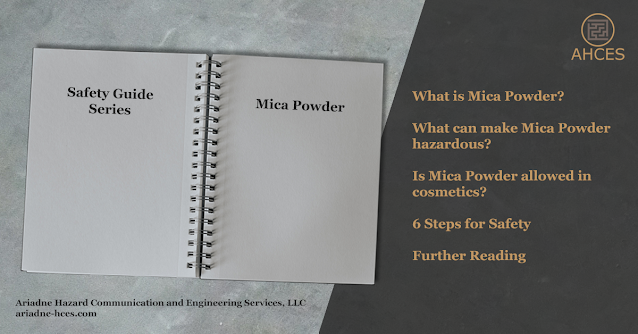Sodium Carbonate Safety Guide
What is Sodium Carbonate?
Sodium Carbonate, also known as disodium carbonate and soda ash, is an organic sodium salt. It has many uses, ranging from being an ingredient in detergents and cleaners to textile processing to human and veterinary medicine.
Sodium carbonate has the CAS Number 497-19-8.
Notable Properties of Sodium Carbonate
In its natural solid form, sodium carbonate is a colorless crystal and when powered it appears white.
What Makes Sodium Carbonate Hazardous?
Sodium carbonate is an irritant, with exposure causing irritation to the skin and eyes. There are also reports of repeated sodium carbonate inhalation causing irritation and damage to the respiratory system.
Sodium Carbonate Frequently Asked Questions
Does sodium carbonate dissolve in water?
Yes, sodium carbonate is soluble in water. It will break down into carbonic acid and sodium hydroxide.
For more information about sodium hydroxide, see the AHCES Lye Safety Guide.
6 Steps for Safety
Step 1: Read the Warnings
When working with a product for the first time, always read all the safety documents first. This includes safety data sheets, which should be provided by the manufacturer or importer of the mica powder. There may also be an OSHA chemical label or a Consumer Protection label on the packaging of the sodium hydroxide product. These documents all contain important information on the hazards of the product and instructions on how to mitigate those hazards.
Different compositions in different products may cause additional hazards to be present beyond the properties of pure sodium hydroxide. Be sure to familiarize yourself with the differences between separate products which contain sodium hydroxide.
Step 2: Prepare Your Workspace
Creating a safe workspace, sometimes referred to as engineering control, is a key component of working safely with any potentially hazardous substance.
Since the primary hazard of sodium carbonate is being an irritant, fine dust that can be aerosolized should be avoided. Fans that would blow sodium carbonate dust around should be avoided. Dust collectors and air filters that draw in and capture any stray sodium carbonate dust are ideal.
Step 3: Gather Your PPE
For handling sodium carbonate, particularly if dusty, you
will need the following PPE.
- Respiratory Protection
- A half-facepiece respirator with filters rated for protection against fine dust.
- A full-facepiece respirator can serve as both respiratory protection and eye protection.
- Eye Protection
- Safety goggles which create a seal around the eyes are needed to prevent any airborne sodium carbonate dust from reaching the eyes.
- Open safety glasses, which do not have a sealing surface, will not work in preventing dust from reaching the eyes.
- Gloves
- Basic disposable gloves will prevent sodium carbonate from touching the skin on the hands and causing irritation.
- Long Sleeves
- Long sleeves will prevent sodium carbonate from touching the skin on the arms and causing irritation.
- Either a long-sleeved shirt, long-sleeved coat, or disposable sleeves will work.
- Launder any contaminated clothes separately to prevent cross-contamination and inform anyone laundering the clothing of the presence of sodium carbonate so they can take any necessary precautions.
Step 4: Clear Your Workspace
Having a clear workspace is an important part of safety. Clutter can cause accidents and can prevent you from noticing if something has spilled.
This is also a good time to double check any engineering controls, like a dust collector, are in proper working order and no filters need to be changed out.
If you are working in a shared space, make sure everyone around you can also remain safe when you are working with sodium carbonate. For those working at home, this can include family members and pets.
Step 5: Do The Work
If engineering controls and PPE are used properly, working with sodium carbonate has minimal hazards.
If work cannot be completed in one sitting, be sure to properly seal any sodium carbonate containers to prevent spills or accidental release when not in use.
Step 6: Clean Up
Dust generation should be avoided when cleaning up. Either a vacuum with a filter or a damp cleaning cloth can be used to pick up spilled or stray sodium carbonate powder while preventing dust generation.
Be sure to dispose of any waste in accordance with local regulations, which can vary by State and county.
Further Reading
The National Library of Medicine has a PubChem article on Sodium Carbonate.
Check out the Safety Guide Series Hub for more safety guides.
Sources Cited
National Center for Biotechnology Information (2024). PubChem Compound Summary for CID 10340, Sodium Carbonate. Retrieved June 25, 2024 from https://pubchem.ncbi.nlm.nih.gov/compound/Sodium-Carbonate.
National Center for Biotechnology Information (2024).
PubChem Annotation Record for , Sodium carbonate, Source: Hazardous Substances
Data Bank (HSDB). Retrieved June 25, 2024 from
https://pubchem.ncbi.nlm.nih.gov.





Comments
Post a Comment